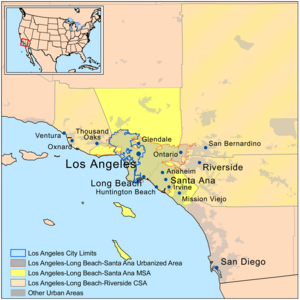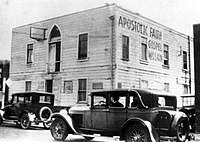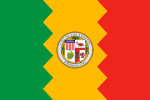The Greater Los Angeles Portal Greater Los Angeles is the most populous metropolitan area in the U.S. state of California, encompassing five counties in Southern California extending from Ventura County in the west to San Bernardino County and Riverside County in the east, with Los Angeles County in the center, and Orange County to the southeast. The Los Angeles–Anaheim–Riverside combined statistical area (CSA) covers 33,954 square miles (87,940 km2), making it the largest metropolitan region in the United States by land area. The contiguous urban area is 2,281 square miles (5,910 km2), whereas the remainder mostly consists of mountain and desert areas. With a population of 18.3 million in 2023, it is the second-largest metropolitan area in the country, behind New York, as well as one of the largest megacities in the world. In addition to being the nexus of the global entertainment industry, including films, television, and recorded music, Greater Los Angeles is also an important center of international trade, education, media, business, tourism, technology, and sports. It is the third-largest metropolitan area by nominal GDP in the world with an economy exceeding $1 trillion in output, behind New York City and Tokyo. There are three contiguous component urban areas in Greater Los Angeles: the Inland Empire, which can be broadly defined as Riverside and San Bernardino counties; the Ventura/Oxnard metropolitan area (Ventura County); and the Los Angeles metropolitan area (also known as Metropolitan Los Angeles or Metro LA) consisting of Los Angeles and Orange counties only. The Census Bureau designates the latter as the Los Angeles–Long Beach–Anaheim metropolitan statistical area (MSA), the fourth largest metropolitan area in the western hemisphere and the second-largest metropolitan area in the United States, by population of 13 million as of the 2020 U.S. census. It has a total area of 4,850 square miles (12,561 km2). Although San Diego–Tijuana borders the Greater Los Angeles area at San Clemente and Temecula, it is not part of it as the two urban areas are not geographically contiguous due to the presence of Camp Pendleton. However, both form part of the Southern California Megalopolis which extends into Tijuana, Baja California, Mexico. Throughout the 20th century, Greater Los Angeles was one of the fastest-growing regions in the United States, but growth has slowed since 2000. ( Full article...) Selected article - The Azusa Street Revival was a historic Pentecostal revival meeting that took place in Los Angeles, California and is the origin of the Pentecostal movement. It was led by William J. Seymour, an African American preacher. It began with a meeting on April 9, 1906, and continued until roughly 1915. The revival was characterized by ecstatic spiritual experiences accompanied by miracles, dramatic worship services, speaking in tongues, and inter-racial mingling. The participants were criticized by the secular media and Christian theologians for behaviors considered to be outrageous and unorthodox, especially at the time. Today, the revival is considered by historians to be the primary catalyst for the spread of Pentecostalism in the 20th century. Did You Know -   • ... that the
Raymond M. Alf Museum of Paleontology, located in
Claremont, California, is the only nationally accredited museum of paleontology on a secondary school campus in the United States? June 2014 Selected imageWikiProject
Related PortalsSelected biography -John Whiteside Parsons (born Marvel Whiteside Parsons; October 2, 1914 – June 17, 1952) was an American rocket engineer, chemist, and Thelemite occultist. Associated with the California Institute of Technology (Caltech), Parsons was one of the principal founders of both the Jet Propulsion Laboratory (JPL) and the Aerojet Engineering Corporation. He invented the first rocket engine to use a castable, composite rocket propellant, and pioneered the advancement of both liquid-fuel and solid-fuel rockets. Born in Los Angeles, Parsons was raised by a wealthy family on Orange Grove Boulevard in Pasadena, California. Inspired by science fiction literature, he developed an interest in rocketry in his childhood and in 1928 began amateur rocket experiments with school friend Edward Forman. He dropped out of Pasadena Junior College and Stanford University due to financial difficulties during the Great Depression, and in 1934 he united with Forman and graduate Frank Malina to form the Caltech-affiliated Guggenheim Aeronautical Laboratory (GALCIT) Rocket Research Group, supported by GALCIT chairman Theodore von Kármán. In 1939 the GALCIT Group gained funding from the National Academy of Sciences (NAS) to work on Jet-Assisted Take Off (JATO) for the U.S. military. After the U.S. entered World War II, they founded Aerojet in 1942 to develop and sell JATO technology; the GALCIT Group became JPL in 1943. ( Full article...)Regions, major cities and districtsRegions
Cities
Cities by countyTopicsCategoriesSelect [►] to view subcategories
Greater Los Angeles
Los Angeles County, California
Orange County, California
Ventura County, California
WikimediaThe following Wikimedia Foundation sister projects provide more on this subject:
Discover Wikipedia using
portals |
The Greater Los Angeles Portal Greater Los Angeles is the most populous metropolitan area in the U.S. state of California, encompassing five counties in Southern California extending from Ventura County in the west to San Bernardino County and Riverside County in the east, with Los Angeles County in the center, and Orange County to the southeast. The Los Angeles–Anaheim–Riverside combined statistical area (CSA) covers 33,954 square miles (87,940 km2), making it the largest metropolitan region in the United States by land area. The contiguous urban area is 2,281 square miles (5,910 km2), whereas the remainder mostly consists of mountain and desert areas. With a population of 18.3 million in 2023, it is the second-largest metropolitan area in the country, behind New York, as well as one of the largest megacities in the world. In addition to being the nexus of the global entertainment industry, including films, television, and recorded music, Greater Los Angeles is also an important center of international trade, education, media, business, tourism, technology, and sports. It is the third-largest metropolitan area by nominal GDP in the world with an economy exceeding $1 trillion in output, behind New York City and Tokyo. There are three contiguous component urban areas in Greater Los Angeles: the Inland Empire, which can be broadly defined as Riverside and San Bernardino counties; the Ventura/Oxnard metropolitan area (Ventura County); and the Los Angeles metropolitan area (also known as Metropolitan Los Angeles or Metro LA) consisting of Los Angeles and Orange counties only. The Census Bureau designates the latter as the Los Angeles–Long Beach–Anaheim metropolitan statistical area (MSA), the fourth largest metropolitan area in the western hemisphere and the second-largest metropolitan area in the United States, by population of 13 million as of the 2020 U.S. census. It has a total area of 4,850 square miles (12,561 km2). Although San Diego–Tijuana borders the Greater Los Angeles area at San Clemente and Temecula, it is not part of it as the two urban areas are not geographically contiguous due to the presence of Camp Pendleton. However, both form part of the Southern California Megalopolis which extends into Tijuana, Baja California, Mexico. Throughout the 20th century, Greater Los Angeles was one of the fastest-growing regions in the United States, but growth has slowed since 2000. ( Full article...) Selected article - The Azusa Street Revival was a historic Pentecostal revival meeting that took place in Los Angeles, California and is the origin of the Pentecostal movement. It was led by William J. Seymour, an African American preacher. It began with a meeting on April 9, 1906, and continued until roughly 1915. The revival was characterized by ecstatic spiritual experiences accompanied by miracles, dramatic worship services, speaking in tongues, and inter-racial mingling. The participants were criticized by the secular media and Christian theologians for behaviors considered to be outrageous and unorthodox, especially at the time. Today, the revival is considered by historians to be the primary catalyst for the spread of Pentecostalism in the 20th century. Did You Know -   • ... that the
Raymond M. Alf Museum of Paleontology, located in
Claremont, California, is the only nationally accredited museum of paleontology on a secondary school campus in the United States? June 2014 Selected imageWikiProject
Related PortalsSelected biography -John Whiteside Parsons (born Marvel Whiteside Parsons; October 2, 1914 – June 17, 1952) was an American rocket engineer, chemist, and Thelemite occultist. Associated with the California Institute of Technology (Caltech), Parsons was one of the principal founders of both the Jet Propulsion Laboratory (JPL) and the Aerojet Engineering Corporation. He invented the first rocket engine to use a castable, composite rocket propellant, and pioneered the advancement of both liquid-fuel and solid-fuel rockets. Born in Los Angeles, Parsons was raised by a wealthy family on Orange Grove Boulevard in Pasadena, California. Inspired by science fiction literature, he developed an interest in rocketry in his childhood and in 1928 began amateur rocket experiments with school friend Edward Forman. He dropped out of Pasadena Junior College and Stanford University due to financial difficulties during the Great Depression, and in 1934 he united with Forman and graduate Frank Malina to form the Caltech-affiliated Guggenheim Aeronautical Laboratory (GALCIT) Rocket Research Group, supported by GALCIT chairman Theodore von Kármán. In 1939 the GALCIT Group gained funding from the National Academy of Sciences (NAS) to work on Jet-Assisted Take Off (JATO) for the U.S. military. After the U.S. entered World War II, they founded Aerojet in 1942 to develop and sell JATO technology; the GALCIT Group became JPL in 1943. ( Full article...)Regions, major cities and districtsRegions
Cities
Cities by countyTopicsCategoriesSelect [►] to view subcategories
Greater Los Angeles
Los Angeles County, California
Orange County, California
Ventura County, California
WikimediaThe following Wikimedia Foundation sister projects provide more on this subject:
Discover Wikipedia using
portals |










































